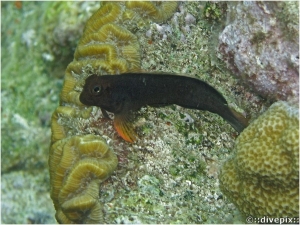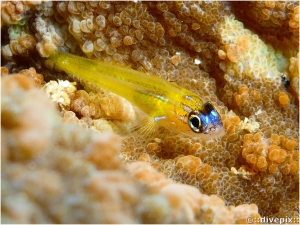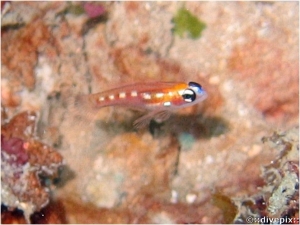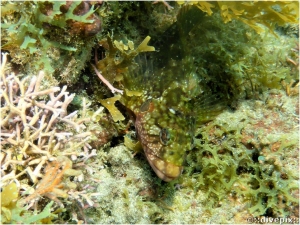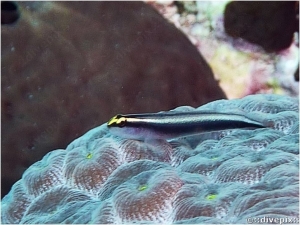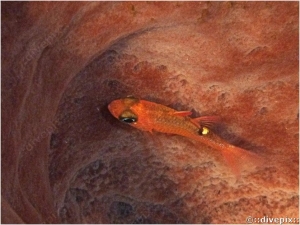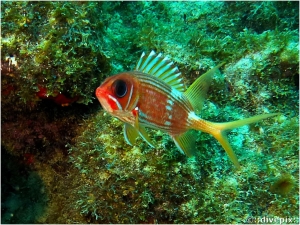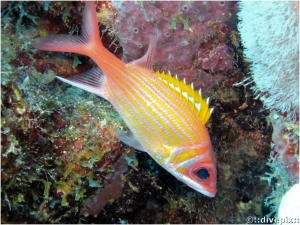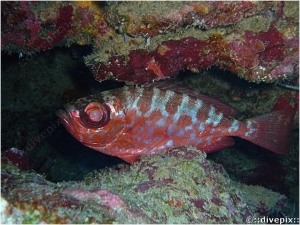




Vous êtes iciPlongeurs
Eric H. Biass
jeudi, 06 décembre 2012 20:13
Redlip Blenny
| Aspect: | Brown body and head with more or less visible cirri above the eyes. Large squarish mouth |
| Population: | Not as common as Secretary Blenny (q.v.). |
| Notable feature: | Red-tipped pectoral fins, prominent globular eyes. |
| Environment: | Any tiny hole in a rock or coral boulder provides a useful home. |
| Behaviour: | Less shy than other blennies. |
Publié dans
Blennies
Tags:
jeudi, 06 décembre 2012 19:57
Peppermint Goby
| Aspect: | Transparent (almost see-through) body with generally two faint dark lateral lines |
| Population: | Common, but difficult to spot due to size and transparency. |
| Notable feature: | Prominent globular eyes with metallic green/blue "eyebrows". |
| Environment: | Rests on coral sand bottom. |
| Behaviour: | Staying totally quiet is its best way of remaining unseen, but will dart away if approached too closely. |
Publié dans
Gobies
Tags:
jeudi, 06 décembre 2012 19:26
Glass Goby or Masked Goby
| Aspect: | Orange translucent body with a series of white oblong patches along the lateral line. |
| Population: | Common, but difficult to spot due to size and transparency. |
| Notable feature: | Prominent globular eyes with characteristic white lines above and below pupil. |
| Environment: | Rests on coral sand bottom. |
| Behaviour: | Like most smal gobies, remaining totally quiet is its best way of remaining unseen, but will dart away if approached too closely. |
Publié dans
Gobies
Tags:
jeudi, 06 décembre 2012 19:15
Hairy Blenny
| Aspect: | At 15 cm length, the Hairy Blenny is amongst the largest in size. Green and brown head, with black and grey zebra body peppered with white spots. |
| Population: | Common, but as usual with blennies difficult to spot. |
| Notable feature: | Eye pupil surrounded by dots, and a white bezelled dark dot adorns the rear part of the gill cover. |
| Environment: | In tight holes in rock or coral boulders. |
| Behaviour: | Difficult to approach and photograph (not to say spot!). Like most blennies, seldom leaves its den. |
Publié dans
Blennies
Tags:
jeudi, 06 décembre 2012 19:00
Cleaning Goby
| Aspect: | Black upper streamlined body, pale belly |
| Population: | Common. |
| Notable feature: | Deep bright yellow V on snout crosses upper part of prominent globular eyes fading into a white band and pale washout on sides of body. |
| Environment: | Often seen resting on Giant Star (q.v) coral boulders. |
| Behaviour: | Unaffected. |
Publié dans
Gobies
Tags:
jeudi, 06 décembre 2012 18:46
Bridled Goby
| Aspect: | Transparent body with generally two faint dark lateral lines |
| Population: | Common, but difficult to spot due to size and transparency. |
| Notable feature: | Prominent globular eyes with dotted crown. |
| Environment: | Rests on coral sand bottom. |
| Behaviour: | Remaining totally quiet is its best way of remaining unseen, but will dart away if approached too closely. |
Publié dans
Gobies
Tags:
mercredi, 05 décembre 2012 23:31
Whitestar Cardinalfish
| Aspect: | Orange body. |
| Population: | A rare encounter, but this may due to very small size and hence propensity to hide (here inside a barrel or vase sponge). |
| Notable feature: | Combined black and yellow stain just aft the dorsal fin. |
| Environment: | Recesses. |
| Behaviour: | Easy to approach, once spotted, at night. |
Publié dans
Apogons
Tags:
mercredi, 05 décembre 2012 19:50
Longspine Squirrelfish
| Aspect: | Usually red head and orange-and-red striped upper body, red centre body, very long deep-V tail fin, but can display paler tones overall with white tail. White "throat". |
| Population: | Common. |
| Notable feature: | No protruding lower jaw but white vertical patch across mid-body distinguishes it from Longjaw Squirrelfish (q.v.), but like the latter sports a silver bar under the eye. |
| Environment: | Under rock and coral boulder recesses. |
| Behaviour: | Easy to approach when caught in recesses. |
Publié dans
Ecureuils
Tags:
mercredi, 05 décembre 2012 18:24
Longjaw Squirrelfish
| Aspect: | Red head and orange-and-red striped body, red tail, and translucent fins. |
| Population: | Occasionally encountered. |
| Notable feature: | Protruding lower jaw (hence name), silver bar under the eye. |
| Environment: | Under rock and coral boulder recesses. |
| Behaviour: | Difficult to approach. |
Publié dans
Ecureuils
Tags:
mardi, 04 décembre 2012 19:49
Glasseye Snapper
| Aspect: | Red body similar in shape to Bigeye (q.v.), but carries distinctive silver patches and lines of various sizes. |
| Population: | Common. |
| Notable feature: | Red can sometimes turn silvery. |
| Environment: | Under rock overhangs, in deeper waters, as of 20 metres, |
| Behaviour: | Easy to approach when found. |
Publié dans
Gros Yeux
Tags:



